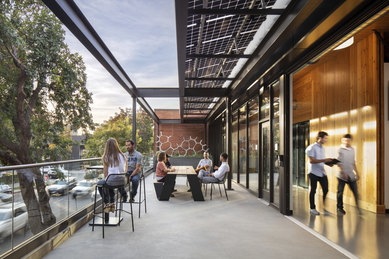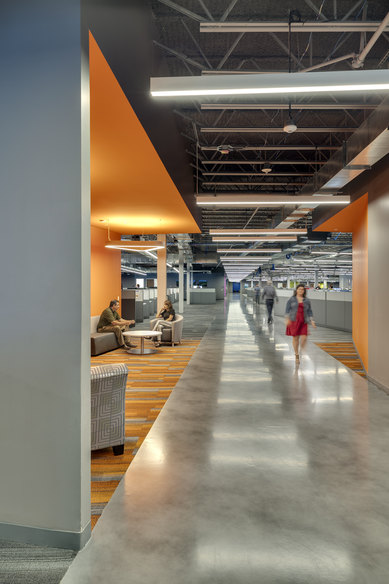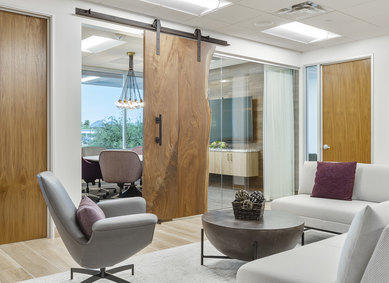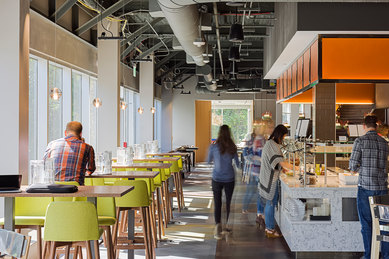Wellbeing, Culture and the Evolving Workplace
This article was previously published in Work Design Magazine.
Across the globe, the events of 2020 and the COVID-19 pandemic brought forth an acute awareness of public health and personal wellbeing. Millions of people were forced to address wellness and work/life balance in new and unexpected ways. As a result, employers have stepped up to offer flexibility, incentives, and amenities to support a new era of work/life integration that promotes health and wellness for all.
Flexibility, Choice and Trust
Corporations have realized that a substantial percentage of staff – or perhaps even their entire workforce – may never return to the office five days a week. Moving forward it is predicted that most workers will spend some portion of their careers working from home, if job functions permit. This change is prompting many leaders to adopt new, more flexible managerial and operational models to address evolving day-to-day organizational needs while also working to preserve the culture that makes their companies unique.
“Employees are relying more on their employers to provide a range of options that address health and wellbeing on all fronts, which ultimately drives a culture of wellness within organizations,” observes Stacie Thornton, a principal and Senior Human Resources Manager at SmithGroup. Companies recognize that each employee’s personal situation is different, and that choice (within reason) can bring out the best in an employee or team, if well-managed and thoughtfully communicated. As a result, savvy employers are monitoring health performance indicators – as well as their bottom lines – to gauge what is working within their organizations, identify opportunities for improvement, and then adjust guidelines, protocols, and managerial styles accordingly.
Leaders across industries recognize that this work revolution is no longer a short-term fix to mitigate unique global conditions. Provided that clients are well-served and employee responsibilities are upheld, flexibility and choice in both remote and in-person work will remain an essential recruiting and retention tool that employers will be expected to offer long after the pandemic subsides. “Considering our current remote work environment, where employees are working, living, parenting, and conducting school-related activities all under one roof, SmithGroup’s focus has shifted from the traditional work/life balance to focus more on work/life integration,” says Thornton. Other companies are following suit.
At SmithGroup, the heads-down focus and enhanced productivity that we are seeing from some teammates working from home prove that the move has been beneficial for them and ultimately for our clients. These teammates attribute increased productivity to a decrease in disruptions that can occur when working in busy, open-office environments. Still, many colleagues have expressed the need to connect and collaborate with others. For those, our physical offices have become places where employees can go for in-person collaboration when a video call will not suffice. Alternatively, staff are also finding solace in the quiet rooms and private spaces within offices when their at-home work environment present challenges.
As we continue to shift away from a traditional five-days-a-week office-based work construct, workplace relationships built upon mutual employee-employer trust will become even more critical in organizational structures that include remote or hybrid work modalities. For managers struggling to trust that employees are indeed working when outside the office, a recent Harvard Business Review article[i] provides data addressing this concern. Research showed that “many managers were also dubious about whether remote workers can remain motivated over time, with 41% agreeing with the statement ‘I am skeptical as to whether remote workers can stay motivated in the long term.’” To mitigate similar concerns within our own organization, SmithGroup’s leadership has committed to providing employees with ample workstyle choices while empowering and trusting teammates to leverage what they need, when they need it. This includes not only flexible remote working hours, but also support resources, education, and strategies for SmithGroup staff at home. We encourage innovation across the organization, in rethinking how and when we work. Challenging the virtual norm, mangers are on the lookout for “Zoom fatigue,” scheduling walking, talking one-on-one and team meetings when possible. We recognize that staff wellbeing is embedded in the very meeting platforms we choose, in how we bring people together, and how we can help each other more deliberately un-tether ourselves from the workspace.
Designing for Continued Success
Whether working at home or in a company’s physical office, long-proven design principles can and should be applied to positively influence health and wellbeing across settings. Employers continue to seek out opportunities to incorporate the following to promote wellness within their workspaces. Forward-thinking organizations are encouraging teammates working remotely to do the same.
- Embrace Connections to Nature
Research shows that connections to nature and outdoor spaces can yield tremendous health benefits, including reduced stress, increased cognitive function and more. As we ease through the COVID-19 pandemic, we continue to work with clients that are exploring incorporating rooftop decks, gardens, sustainable landscape design, walking trails, and strategically placed architectural design elements to help promote wellbeing, health, safety, and responsible social distancing for employees returning to the office. (Image #1)
In urban environments or locations with limited access to nature and outdoor spaces, natural daylight, lighting design, biophilic design and plantings also remain viable and effective alternatives that can help enhance wellbeing in a variety of spaces. Pre- and post-occupancy data collected from several of SmithGroup’s urban-centered locations (Boston, Chicago, San Francisco) confirms that the use of these tactics has helped to elevate mood and increase productivity and cognitive function within the office.
- Enhance Indoor Environments & Systems
COVID-19 has highlighted the importance of indoor air quality and the critical role mechanical systems play in supporting human health outcomes. The general populous has become more aware of MEP systems, MERV filters, UV lighting and the benefits of other healthy building interventions and tools like touchless technology, voice command, anti-microbial surfaces, and smart sensors. Building owners are more focused than ever on enhancements that promote the safety of occupants. We anticipate this will become an important selling point to prospective tenants, just as LEED-certified buildings have been and continues to be.
SmithGroup is not alone in this prediction. Joseph Allen, Director of the Harvard T.H. Chan School of Public Health’s Healthy Buildings Program, reports conducting advisory conversations on these topics with c-suite leaders across all market sectors, from healthcare and universities, to retail and entertainment. “It’s very indicative that COVID-19 has accelerated widespread recognition of healthy buildings, because leaders now recognize that healthy buildings are central to their business,” says Allen. We know that in the future, “healthy buildings will be the norm, not the exception.” Appreciation and adoption of this mindset will differentiate forward-thinking landlords from those that think about healthy building strategy as merely “a risk management tool for a down market.”
Among property owners who have not invested in MEP systems that prioritize and promote occupant wellbeing, one of the primary barriers is first cost. However, research shows that the up-front expense to design a healthy building far outweighs human capital costs – the percentage of expense to recruit, onboard and retain the great people you want to be part of your organization. Real estate-related costs account for an average 7-10% of an organization’s total expense. Employers need to ask themselves, “How we can provide the best possible experience for our employees?” and “What kinds of environments are needed to create a deliberate culture of wellbeing?” Healthy building systems are a must-have, especially given the anxiety and safety concerns that employees will harbor for the near future and beyond due to the pandemic.
- Incorporate Design Features and Amenities to Prompt Wellbeing
As designers, we are attuned to how space-based solutions can promote positive mental and physical health in the workplace. However, if these solutions are implemented as stand-alone features that do not align with or promote a larger, more comprehensive approach to wellness, then the impacts are finite. A truly healthy workplace uses design as a holistic measure to advance physical, operational, and social aspects of human health, productivity, and wellbeing.
For instance, elements like indoor walking tracks incorporated into circulation spaces are becoming increasingly popular and are used to facilitate walking meetings. (Image #2) A variety of wellness rooms and amenities like bistros and speakeasy-style lounges also help to promote social connectivity. Another trend in workplace design has been the inclusion of spaces or elements that evoke the feeling of working at home or in a café. Partnering with retailers like CB2 or Restoration Hardware – a departure from working with traditional commercial vendors – designers have been able to incorporate furniture and fixtures that achieve a more causal residential feel and skillfully bridge a variety of workspaces. (Image #3).
These design concepts are not new, nor are they driven by demand from new generations in the workforce. They are merely enhanced, more deliberate, and much more comfortable and inviting versions of the proverbial “water cooler” as a gathering place. As employees gradually return to physical offices, these kinds of spaces will continue to play an important role in supporting wellbeing and culture, as will private focus rooms, collaborative zones and spaces necessary to address a range of other needs and tasks.
Wellness Incentives, Resources and Programs
For most workers and employers today, the definition of wellness and wellbeing has expanded, along with the benefits and corporate policies that support it. “Most people think of physical health when talking of wellness. That’s true, but that facet has become more of the ‘basic’ offering,” says Ed Dodge, Vice President and SmithGroup’s Director of Human Resources. “We are finding that employees want and expect us to provide enhanced wellness support in areas like financial, intellectual, social, emotional, mental, and environmental wellness, all of which we support through formal programs, policies and vendors.”
Many employers that already had robust benefits and business-to-business partnerships are increasing and expanding those relationships with a focus on additional options like telehealth consults for mental and physical wellbeing, education and training programs, and an expanded list of partner groups that support healthier lifestyles and workstyles. As a result, human resource professionals are getting creative. We now need to offer a “variety of accessible educational resources and services that are perhaps less traditional, complimenting a diverse array of employee needs and lifestyles,” says Thornton.
With this in mind, it’s no surprise that SmithGroup is seeing a rise in clients looking to incorporate healthy, on-site food options to help encourage wellness and keep employees engaged on campus. In select organizations, clients are going a step further, investing in micro-markets and grab-n-go eateries within their properties. Though many Americans were taking steps to eat healthier before the COVID-19 pandemic, experts predict this trend will continue, if not increase, after this health crisis subsides. And while the pandemic presented great challenges for food service, lifestyle and fitness providers, it has also presented unique opportunities for these businesses to develop new and exciting win-win-win partnerships with corporations and their employees. If successfully orchestrated, imagine the benefits that could be achieved by all parties while advancing a myriad of health and wellbeing objectives!
Culture Reigns
Savvy leaders have gone to great lengths to implement flexible policies, create healthy environments, enhance benefit offerings, and employ risk reduction strategies to keep staff safe and productive during trying times. While these measures have been successful in achieving short-term objectives, many companies remain concerned about the erosion of their corporate cultures in the absence of the physical workplace that often serves as a home base for collaboration.
Harvard’s Joseph Allen confirms that a growing number of C-suite leaders recognize the importance of preserving culture as part of long-term planning. “Early on in the pandemic, the smart leaders had their eye on managing the immediate crisis but were also already thinking about post-crisis and how the world would be different, knowing that we will eventually get out of this,” says Allen.
Some companies have terminated leases, closed offices, and shifted their entire workforce to remote to mitigate costs. For many, this is temporary. We believe that the office is not gone and we, like many others, have strategies in place to facilitate future growth.
Successful growth strategies require place-based solutions that enable people to come together and innovate in healthy, beautiful and inspiring spaces. This is central to design culture. Creative industries such as our own have survived the pandemic, delivering and communicating through technology. But we have also felt the twinge of our peers’ physical absence and missed the sparks of innovation and creativity that fly when people are able to collaborate within a shared space. Culture binds us, and we look forward to the day when we can safely be back in the office together.
Author Bio: Mark Adams describes his work style as "a leader, collaborator, psychologist and motivator, all within the context of a strong work ethic." He’s joking about the psychologist part, but it speaks to his broad role as Principal and Workplace Studio Leader for Interior Architecture in the Phoenix office. With more than 30 years of experience, Mark applies his award-winning design skills as director and principal designer, and project manager as well as his leadership skills as mentor to the Phoenix staff. He also has contributed his expertise as a presenter at Tradeline, NeoCon, International Facility Management Association (IFMA) and other national conferences, and as an editor to the American Institute of Architects Handbook of Professional Practice. In his free time, Mark likes to work on his golf game—come to think of it, another pursuit that combines skills and psychology.



